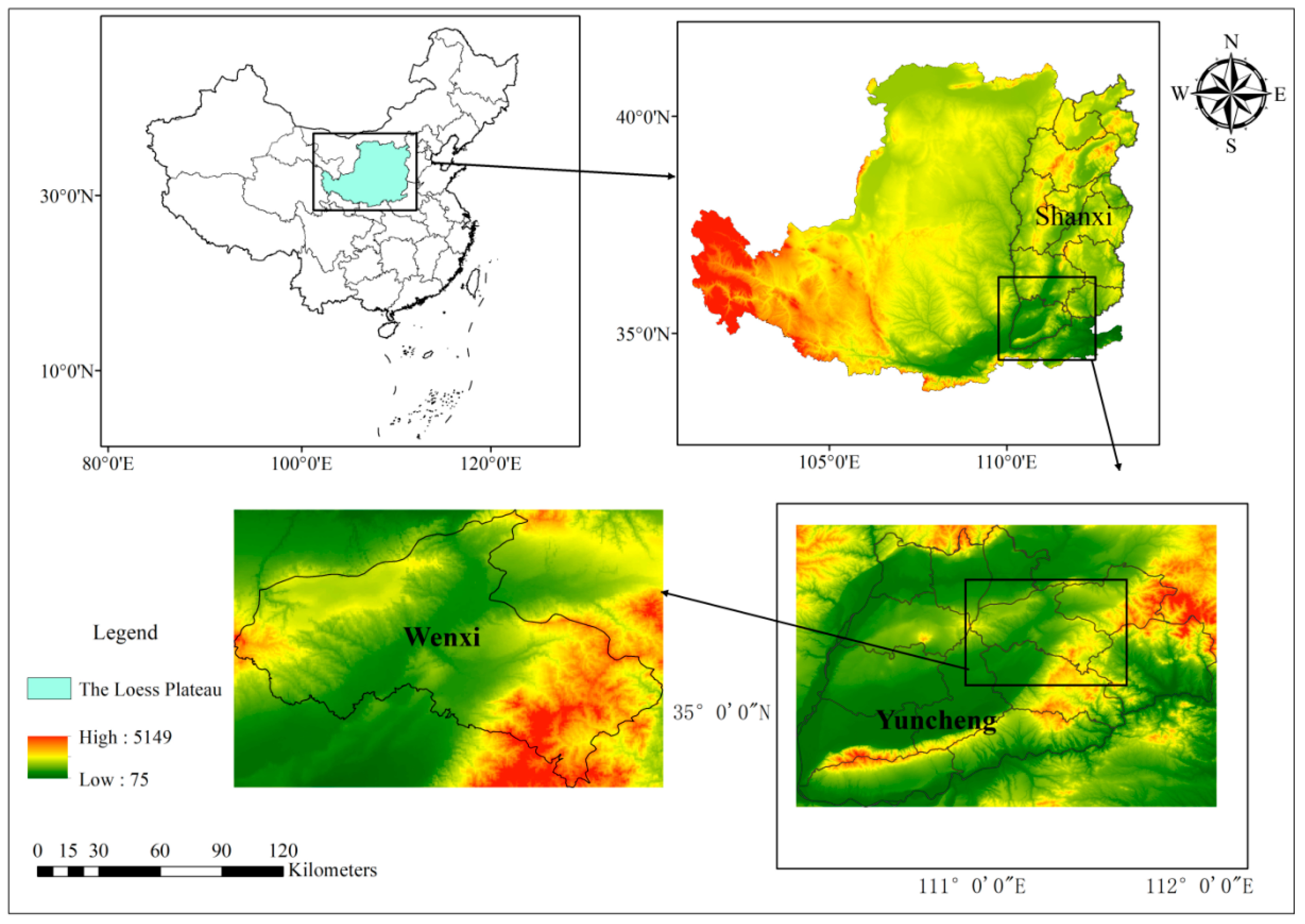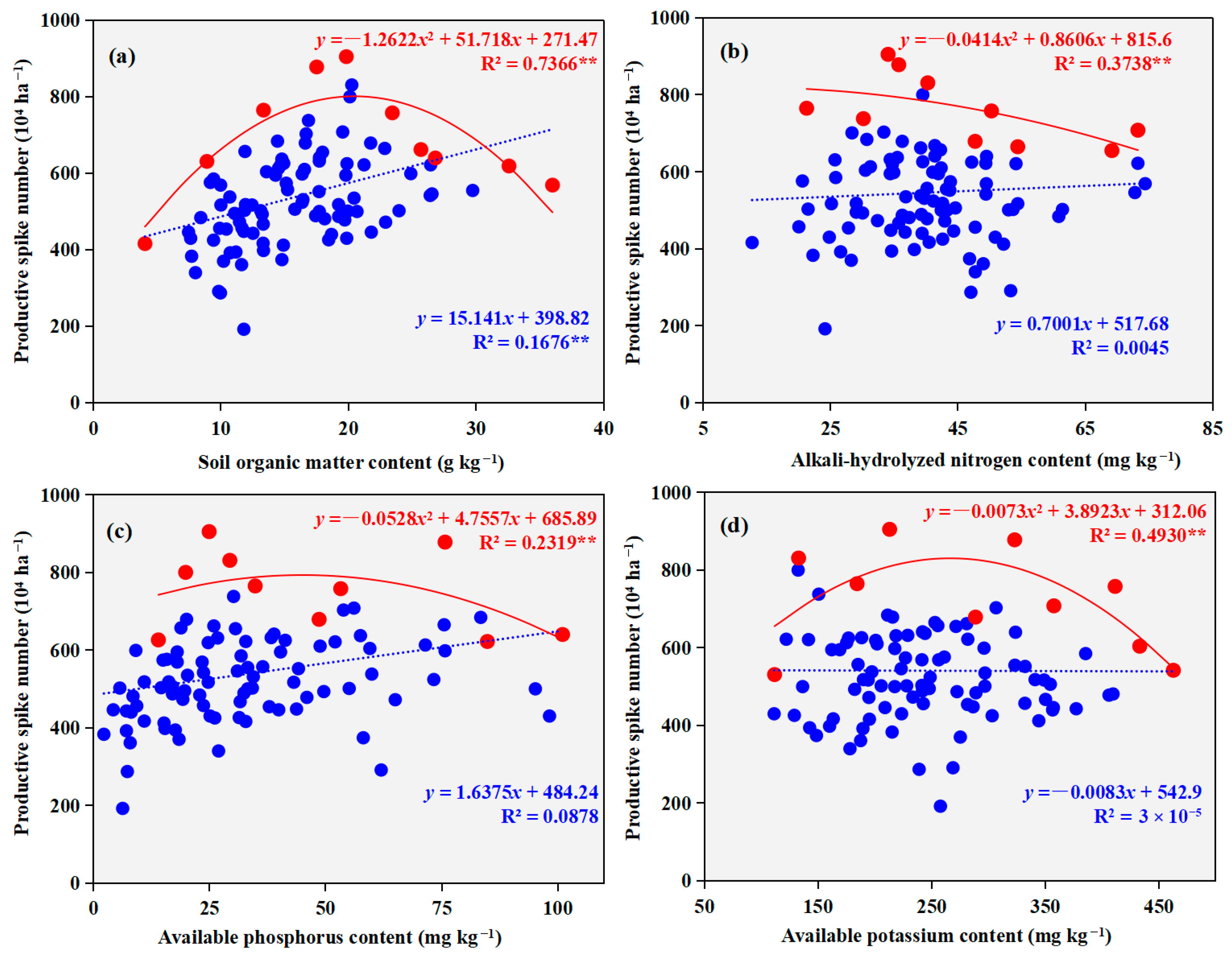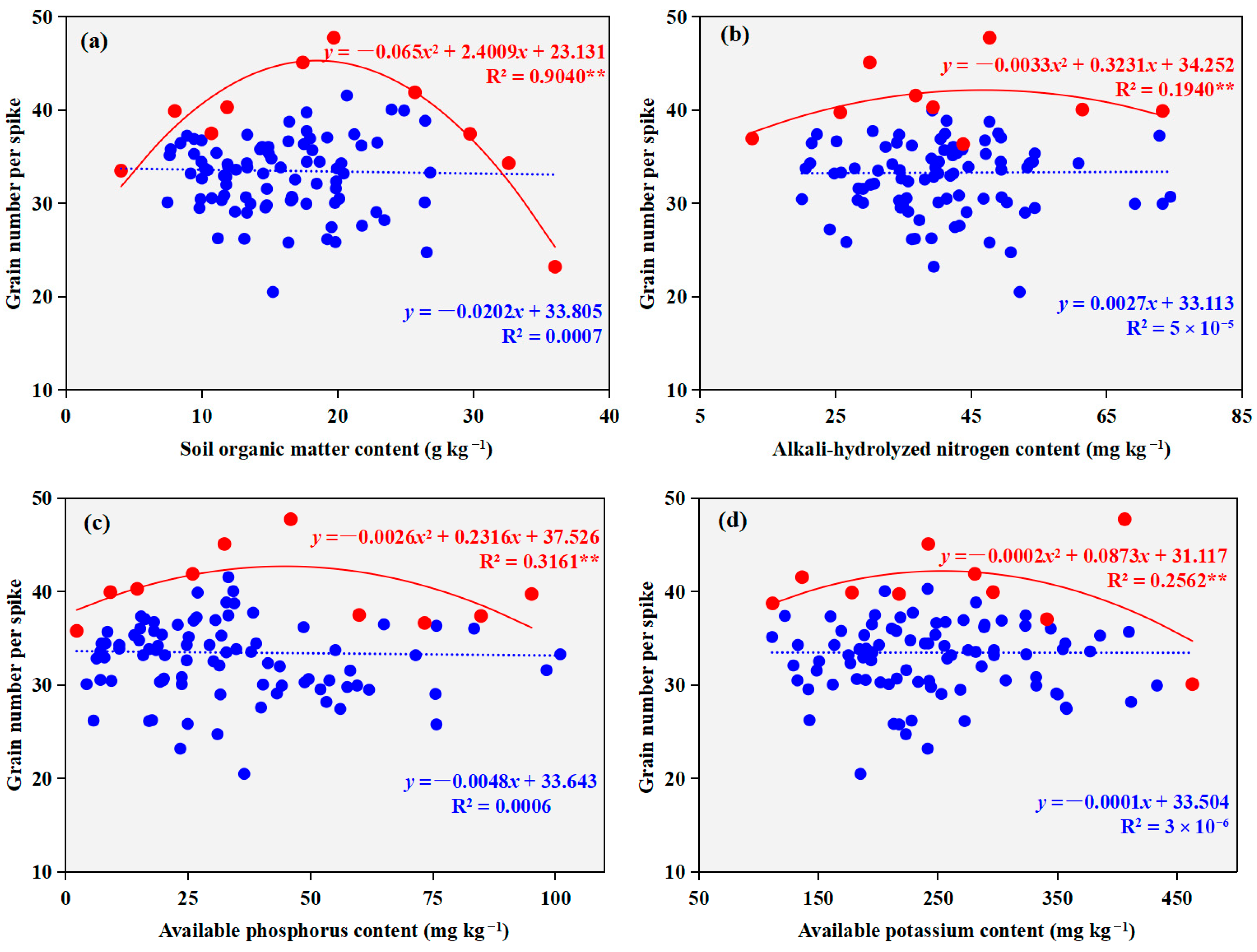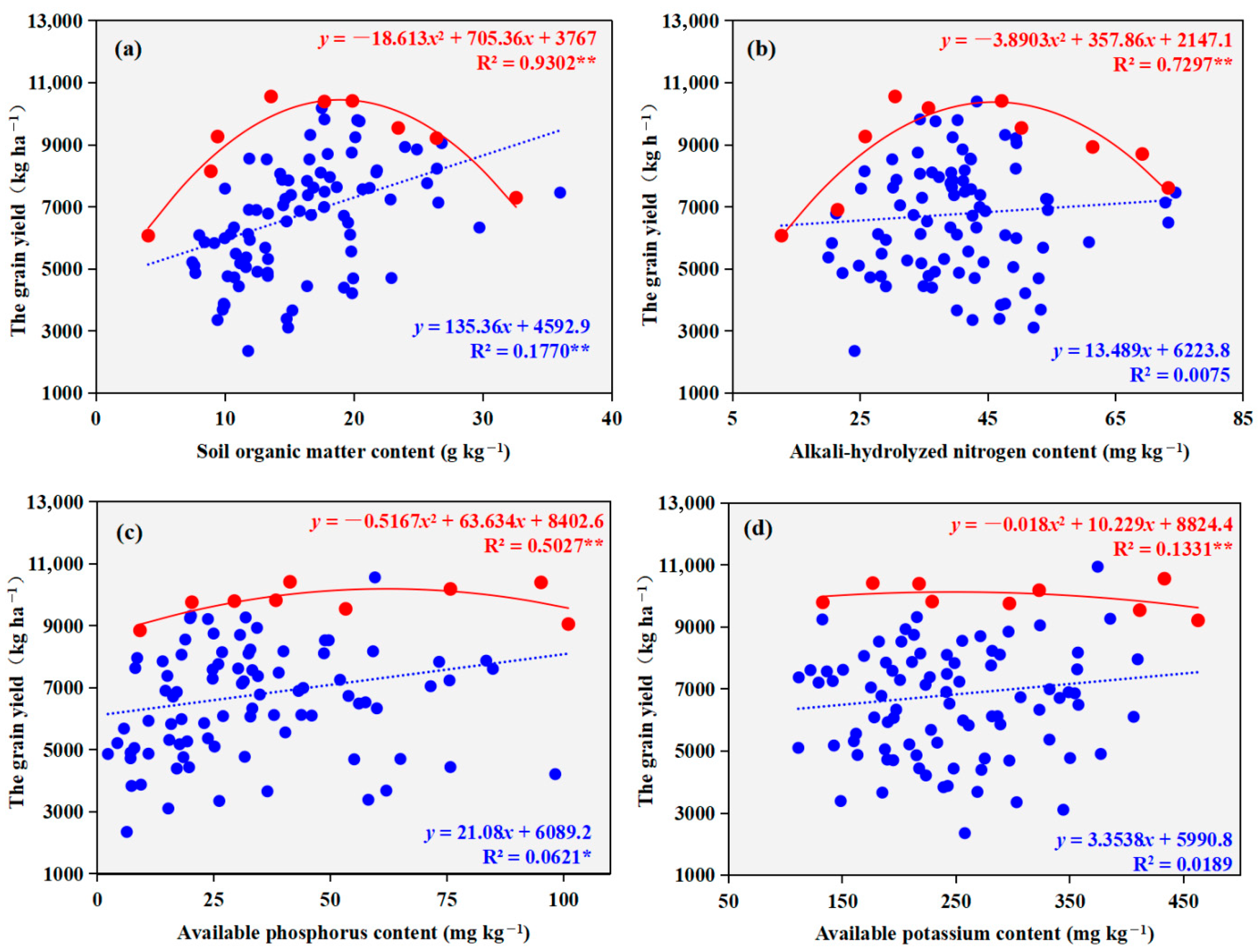Assessment of the Winter Wheat Yield Gap for Smallholder Farmers in the Loess Plateau via Boundary Line Analysis
Abstract
1. Introduction
2. Materials and Methods
2.1. Study Area
2.2. Data Collection
2.3. Boundary Line Analysis
2.4. Data Processing and Visualization
3. Results
3.1. Variation in Winter Wheat Yield and Its Components
3.2. Soil Nutrient Distribution
3.3. Relationships Between Soil Nutrients and Yield Components
4. Discussion
4.1. Variation in Yield Components and Underlying Causes
4.2. Soil Organic Matter and Available Phosphorus as Key Yield Drivers
4.3. Non-Linear Nutrient Responses and Yield Inhibition at High Levels
4.4. Optimal Nutrient Ranges and Differential Responses of Yield Components
4.5. Study Limitations and Future Research Perspectives
5. Conclusions
Author Contributions
Funding
Data Availability Statement
Acknowledgments
Conflicts of Interest
References
- FAO; IFAD; UNICEF; WFP; WHO. The State of Food Security and Nutrition in the World 2024–Financing to End Hunger, Food Insecurity and Malnutrition in All Its Forms; FAO: Rome, Italy, 2024; p. 3. [Google Scholar]
- Williamson, E.; Ross, I.L.; Wall, B.T.; Hankamer, B. Microalgae: Potential novel protein for sustainable human nutrition. Trends Plant Sci. 2024, 29, 370–382. [Google Scholar] [CrossRef]
- van Dijk, M.; Morley, T.; Rau, M.L.; Saghai, Y. A meta-analysis of projected global food demand and population at risk of hunger for the period 2010–2050. Nat. Food 2021, 2, 494–501. [Google Scholar] [CrossRef]
- Lv, F.; Deng, L.; Zhang, Z.; Wang, Z.; Wu, Q.; Qiao, J. Multiscale analysis of factors affecting food security in China, 1980–2017. Environ. Sci. Pollut. Res. 2022, 29, 6511–6525. [Google Scholar] [CrossRef] [PubMed]
- Senthilkumar, K.; Rodenburg, J.; Dieng, I.; Vandamme, E.; Sillo, F.S.; Johnson, J.M.; Rajaona, A.; Ramarolahy, J.A.; Gasore, R.; Abera, B.B.; et al. Quantifying rice yield gaps and their causes in Eastern and Southern Africa. J. Agron. Crop Sci. 2020, 206, 478–490. [Google Scholar] [CrossRef]
- Oldfield, E.E.; Bradford, M.A.; Wood, S.A. Global meta-analysis of the relationship between soil organic matter and crop yields. Soil 2019, 5, 15–32. [Google Scholar] [CrossRef]
- Hajjarpoor, A.; Soltani, A.; Zeinali, E.; Kashiri, H.; Aynehband, A.; Vadez, V. Using boundary line analysis to assess the on-farm crop yield gap of wheat. Field Crops Res. 2018, 225, 64–73. [Google Scholar] [CrossRef]
- Alwitwat, R.M.A. Assessing the impact of soil quality on plant growth and crop yields. J. Res. Appl. Sci. Biotechnol. 2022, 1, 114–121. [Google Scholar] [CrossRef]
- Khaliq, T.; Gaydon, D.S.; Ahmad, M.U.D.; Cheema, M.J.M.; Gull, U. Analyzing crop yield gaps and their causes using cropping systems modelling–A case study of the Punjab rice-wheat system, Pakistan. Field Crops Res. 2019, 232, 119–130. [Google Scholar] [CrossRef]
- Huang, N.; Dang, H.; Mu, W.; Ma, J.; Ma, Y.; Wang, L.; Shi, M.; Tian, H.; Liu, J.; Chen, Y.; et al. High yield with efficient nutrient use: Opportunities and challenges for wheat. iScience 2023, 26, 106135. [Google Scholar] [CrossRef]
- Cao, H.Z.; Li, Y.N.; Chen, G.F.; Chen, D.D.; Qu, H.R.; Ma, W.Q. Identifying the limiting factors driving the winter wheat yield gap on smallholder farms by agronomic diagnosis in North China Plain. J. Integr. Agric. 2019, 18, 1701–1713. [Google Scholar] [CrossRef]
- Tanaka, T.S.T.; Kono, Y.; Matsui, T. Assessing the spatial variability of winter wheat yield in large-scale paddy fields of Japan using structural equation modelling. In Proceedings of the 12th European Conference on Precision Agriculture, Montpellier, France, 8–11 July 2019; pp. 751–757. [Google Scholar]
- Woźniak, A. Effect of crop rotation and cereal monoculture on the yield and quality of winter wheat grain and on crop infestation with weeds and soil properties. Int. J. Plant Prod. 2019, 13, 177–182. [Google Scholar] [CrossRef]
- Bulletin of Major Data from the Third National Land Resource Survey. Available online: http://www.news.cn/politics/2021-08/26/c_1127797077.htm (accessed on 20 July 2025). (In Chinese).
- SPBS (Shanxi Provincial Bureau of Statistics); SONBSS (Survey Office of the National Bureau of Statistics in Shanxi). Shanxi Statistical Yearbook 2024; China Statistics Press: Beijing, China, 2025. (In Chinese) [Google Scholar]
- Bao, S.D. Soil and Agricultural Chemistry Analysis, 3rd ed.; China Agriculture Press: Beijing, China, 2000; pp. 25–114. (In Chinese) [Google Scholar]
- Xue, J.F.; Liu, C.B.; Han, J.J.; Yang, W.B.; Lin, W.; Gao, Z.Q. Assessment of the grain yield gap and its limiting factor of winter wheat in Wenxi country based on the farmer scale. J. Shanxi Agric. Univ. (Nat. Sci. Ed.) 2022, 42, 26–34. [Google Scholar] [CrossRef]
- Webb, R.A. Use of boundary line in analysis of biological data. J. Hortic. Sci. 1972, 47, 309–319. [Google Scholar] [CrossRef]
- Li, R.; Li, M.; Ashraf, U.; Liu, S.; Zhang, J. Exploring the relationships between yield and yield-related traits for rice varieties released in China from 1978 to 2017. Front. Plant Sci. 2019, 10, 543. [Google Scholar] [CrossRef] [PubMed]
- Thilakarathne, C.L.; Tausz-Posch, S.; Cane, K.; Norton, R.M.; Tausz, M.; Seneweera, S. Intraspecific variation in growth and yield response to elevated CO2 in wheat depends on the differences of leaf mass per unit area. Funct. Plant Biol. 2012, 40, 185–194. [Google Scholar] [CrossRef]
- Azevedo, R.P.; Salcedo, I.H.; Lima, P.A.; Fraga, V.S.; Lana, R.M.Q. Mobility of phosphorus from organic and inorganic source materials in a sandy soil. Int. J. Recycl. Org. Waste Agric. 2018, 7, 153–163. [Google Scholar] [CrossRef]
- Ukalska-Jaruga, A.; Siebielec, G.; Siebielec, S.; Pecio, M. The impact of exogenous organic matter on wheat growth and mineral nitrogen availability in soil. Agronomy 2020, 10, 1314. [Google Scholar] [CrossRef]
- Shen, Y.; Zhang, T.; Cui, J.; Chen, S.; Han, H.; Niang, T. Subsoiling increases aggregate-associated organic carbon, dry matter, and maize yield on the North China Plain. PeerJ 2021, 9, e11099. [Google Scholar] [CrossRef]
- Fletcher, D.M.M.; Ruiz, S.; Dias, T.; Petroselli, C.; Roose, T. Linking root structure to functionality: The impact of root system architecture on citrate–enhanced phosphate uptake. New Phytol. 2020, 227, 376–391. [Google Scholar] [CrossRef]
- Xue, L.; Khan, S.; Sun, M.; Anwar, S.; Ren, A.; Gao, Z.; Lin, W.; Xue, J.; Yang, Z.; Deng, Y. Effects of tillage practices on water consumption and grain yield of dryland winter wheat under different precipitation distribution in the loess plateau of China. Soil Tillage Res. 2019, 191, 66–74. [Google Scholar] [CrossRef]
- Yang, L.; Wu, Y.; Wang, Y.; An, W.; Jin, J.; Sun, K.; Wang, X. Effects of biochar addition on the abundance, speciation, availability, and leaching loss of soil phosphorus. Sci. Total Environ. 2021, 758, 143657. [Google Scholar] [CrossRef]
- Fageria, N.K.; Dos Santos, A.B.; Moreira, A. Yield, nutrient uptake, and changes in soil chemical properties as influenced by liming and iron application in common bean in a no-tillage system. Commun. Soil Sci. Plant Anal. 2010, 41, 1740–1749. [Google Scholar] [CrossRef]
- Casanova, D.; Goudriaan, J.; Forner, M.M.C.; Withagen, J.C.M. Rice yield prediction from yield components and limiting factors. Eur. J. Agron. 2002, 17, 41–61. [Google Scholar] [CrossRef]
- George, E.; Horst, W.J.; Neumann, E. Adaptation of plants to adverse chemical soil conditions. In Marschner’s Mineral Nutrition of Higher Plants, 3rd ed.; Marschner, P., Ed.; Academic Press: Amsterdam, The Netherlands, 2012; pp. 409–472. [Google Scholar] [CrossRef]
- Tonkin, R. The Influence of Seeding Density and Environmental Factors on Grain Quality of Main Stems and Tillers of Wheat in South Australia. Ph.D. Thesis, The University of Adelaide, Adelaide, Australia, 2004. [Google Scholar]
- Brocklehurst, P.A.; Moss, J.P.; Williams, W. Effects of irradiance and water supply on grain development in wheat. Ann. Appl. Biol. 1978, 90, 265–276. [Google Scholar] [CrossRef]
- Jacoby, R.; Peukert, M.; Succurro, A.; Koprivova, A.; Kopriva, S. The role of soil microorganisms in plant mineral nutrition—Current knowledge and future directions. Front. Plant Sci. 2017, 8, 1617. [Google Scholar] [CrossRef]
- Lazcano, C.; Gómez-Brandón, M.; Revilla, P.; Domínguez, J. Short-term effects of organic and inorganic fertilizers on soil microbial community structure and function. Biol. Fertil. Soils 2013, 49, 723–733. [Google Scholar] [CrossRef]
- Wachsman, G.; Sparks, E.E.; Benfey, P.N. Genes and networks regulating root anatomy and architecture. New Phytol. 2015, 208, 26–38. [Google Scholar] [CrossRef]
- Ma, S.C.; Wang, T.C.; Guan, X.K.; Zhang, X. Effect of sowing time and seeding rate on yield components and water use efficiency of winter wheat by regulating the growth redundancy and physiological traits of root and shoot. Field Crops Res. 2018, 221, 166–174. [Google Scholar] [CrossRef]
- Pan, X.Y.; Wang, G.X.; Yang, H.M.; Wei, X.P. Effect of water deficits on within-plot variability in growth and grain yield of spring wheat in northwest China. Field Crops Res. 2003, 80, 195–205. [Google Scholar] [CrossRef]
- Lu, D.; Lu, F.; Yan, P.; Cui, Z.; Chen, X. Elucidating population establishment associated with N management and cultivars for wheat production in China. Field Crops Res. 2014, 163, 81–89. [Google Scholar] [CrossRef]
- Santiago-Arenas, R.; Dhakal, S.; Ullah, H.; Agarwal, A.; Datta, A. Seeding, nitrogen and irrigation management optimize rice water and nitrogen use efficiency. Nutr. Cycl. Agroecosyst. 2021, 120, 325–341. [Google Scholar] [CrossRef]
- Yang, H.; Wu, G.; Mo, P.; Chen, S.; Wang, S.; Xiao, Y.; Ma, H.; Wen, T.; Guo, X.; Fan, G. The combined effects of maize straw mulch and no-tillage on grain yield and water and nitrogen use efficiency of dry-land winter wheat (Triticum aestivum L.). Soil Tillage Res. 2020, 197, 104485. [Google Scholar] [CrossRef]
- Devatwal, P.; Meena, S.K.; Indliya, P. Role of bio-fertilizers in phosphorus transformation. In Recent Innovative Approaches in Agricultural Science; Yadav, G.K., Dadhich, S.U., Bhateshwar, M.C., Eds.; Bhumi Publishing: Maharashtra, India, 2022; pp. 1–218. [Google Scholar]
- Bibi, F.; Saleem, I.S.; Ehsan, S.; Jamil, S.; Ullah, H.; Mubashir, M.; Kiran, S.; Ahmad, I.; Irshad, I.; Saleem, M.; et al. Effect of various application rates of phosphorus combined with different zinc rates and time of zinc application on phytic acid concentration and zinc bioavailability in wheat. Agric. Nat. Resour. 2020, 54, 265–272. [Google Scholar] [CrossRef]
- Nguyen, V.L.; Palmer, L.; Stangoulis, J. Higher photochemical quenching and better maintenance of carbon dioxide fixation are key traits for phosphorus use efficiency in the wheat breeding line, RAC875. Front. Plant Sci. 2021, 12, 816211. [Google Scholar] [CrossRef] [PubMed]
- Ahmad, Z.; Barutçular, C.; Waraich, E.A.; Ahmad, A.; Ayub, M.A.; Tariq, R.M.S.; Iqbal, M.A.; Sabagh, A.E. Physiological mechanisms of plants involved in phosphorus nutrition and deficiency management. In Plant Abiotic Stress Physiology, 1st ed.; Hakeem, K.R., Aftab, T., Eds.; Apple Academic Press: New York, NY, USA, 2022; pp. 101–118. [Google Scholar]
- Jan, A.L.; Amanullah Mihoub, A.; Fawad, M.; Saeed, M.F.; Khan, I.; Radicetti, E.; Jamal, A. Enhancing wheat performance through phosphorus and zinc management strategies under varied irrigation regimes. Environ. Dev. Sustain. 2024, 1–24. [Google Scholar] [CrossRef]
- Tang, X.; Liu, H.; Zhang, W. Physiological characteristics, crop growth and grain yield of twelve wheat varieties cultivated in the North China Plain. Agronomy 2023, 13, 3041. [Google Scholar] [CrossRef]








Disclaimer/Publisher’s Note: The statements, opinions and data contained in all publications are solely those of the individual author(s) and contributor(s) and not of MDPI and/or the editor(s). MDPI and/or the editor(s) disclaim responsibility for any injury to people or property resulting from any ideas, methods, instructions or products referred to in the content. |
© 2025 by the authors. Licensee MDPI, Basel, Switzerland. This article is an open access article distributed under the terms and conditions of the Creative Commons Attribution (CC BY) license (https://creativecommons.org/licenses/by/4.0/).
Share and Cite
Han, J.-J.; Xia, X.-P.; Liu, H.; Wang, J.-H.; Qi, Z.-W.; Wang, Y.-C.; Lin, W.; Gao, Z.-Q.; Ma, S.-T.; Xue, J.-F. Assessment of the Winter Wheat Yield Gap for Smallholder Farmers in the Loess Plateau via Boundary Line Analysis. Plants 2025, 14, 3375. https://doi.org/10.3390/plants14213375
Han J-J, Xia X-P, Liu H, Wang J-H, Qi Z-W, Wang Y-C, Lin W, Gao Z-Q, Ma S-T, Xue J-F. Assessment of the Winter Wheat Yield Gap for Smallholder Farmers in the Loess Plateau via Boundary Line Analysis. Plants. 2025; 14(21):3375. https://doi.org/10.3390/plants14213375
Chicago/Turabian StyleHan, Jing-Jing, Xian-Ping Xia, Hao Liu, Jia-Hui Wang, Ze-Wei Qi, Yue-Chao Wang, Wen Lin, Zhi-Qiang Gao, Shou-Tian Ma, and Jian-Fu Xue. 2025. "Assessment of the Winter Wheat Yield Gap for Smallholder Farmers in the Loess Plateau via Boundary Line Analysis" Plants 14, no. 21: 3375. https://doi.org/10.3390/plants14213375
APA StyleHan, J.-J., Xia, X.-P., Liu, H., Wang, J.-H., Qi, Z.-W., Wang, Y.-C., Lin, W., Gao, Z.-Q., Ma, S.-T., & Xue, J.-F. (2025). Assessment of the Winter Wheat Yield Gap for Smallholder Farmers in the Loess Plateau via Boundary Line Analysis. Plants, 14(21), 3375. https://doi.org/10.3390/plants14213375






